Skoda Octavia vRS Estate


- Skoda Octavia vRS - we welcome the practical performance wagon
- Why we didn’t choose the plug-in hybrid Octavia vRS iV
- The car that just loves to reset itself
- Skoda Octavia vRS - quiet on the outside, noisy on the inside
- Where it all began for the Skoda Octavia vRS
- The Skoda Octavia’s Simply Clever features
- What's fuel economy like in the Octavia vRS TSI?
- A tale of two Skoda estates
- How does the Octavia cope as a family car?
- All good things must come to an end...
- A second opinion on the Skoda Octavia VRs: first impressions
Skoda Octavia vRS - we welcome the practical performance wagon
Six years since we last ran a Skoda Octavia vRS, we're welcoming the latest generation model to the HJ fleet.

Date: 20 October 2021 | Current mileage: 2240 | Claimed economy: 40.3mpg | Actual economy: 32.1mpg
Following on from the Audi RS4 Avant and Volvo V60 Polestar Engineered I’ve run over the past 12 months, it’s time for something different. No not really, it’s another sporty estate. Yes you can see a pattern emerging here. So we’re welcoming the new Skoda Octavia vRS Estate to our fleet.
This isn’t the first Octavia vRS I’ve run on HonestJohn.co.uk. In 2015 I ran the previous generation model - a 2.0 TSI Estate manual in Meteor Grey. At the time my daughter had just been born so the Octavia proved the ideal family transport. Fast forward six years and her younger brother has just arrived. It seems a new arrival coincides with a new Octavia vRS.
I’ve stuck with a petrol engine - the 2.0 TSI is the same four cylinder turbocharged engine as before but power has been upped from the 220PS in the previous model to 245PS. Torque has also increased, up 20Nm to 370Nm in total.
This time I’ve swapped the manual gearbox in favour of the seven-speed DSG option - although that does add around £1700 to the price. Going for the DSG doesn’t affect fuel economy - the official WLTP figures say the 2.0 TSI should return 40.3mpg while it’s actually a fraction quicker than the manual from 0-62mph, taking 6.7 seconds.
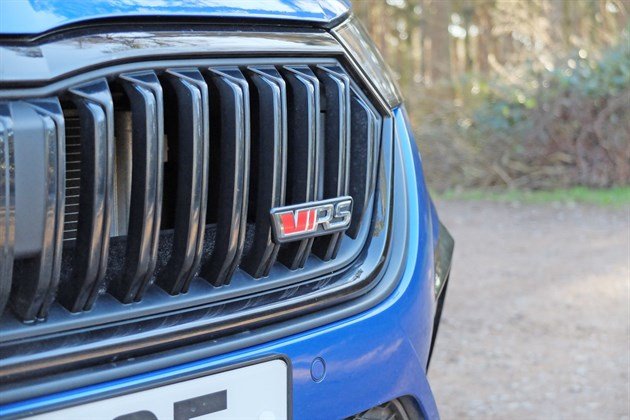
What is remarkable is how prices have increased - the Octavia vRS is no longer the bargain it once was. In 2015, the Octavia vRS Estate we ran had a list price of £25,000 while the current model starts at £33,495. That’s an increase of £8500 in just six years.
Over the next six months we’ll be investigating whether the new Octavia vRS Estate is still the ideal family estate as its predecessor is. We’ll also be looking at whether it’s worth the more expensive price tag.
First impressions are very positive though. The Race Blue metallic paint looks really fetching, although I was very tempted by the Hyper Green paintwork - although the fact we own a Dragon Green Skoda Superb Estate might have meant a bit of a clash on the driveway.
With three children, the Superb is one of the few cars we can all comfortably fit in, so it will be intriguing to see how the Octavia Estate compares over the coming months.
Why we didn’t choose the plug-in hybrid Octavia vRS iV
The latest Octavia vRS is now available as a PHEV alongside the usual petrol and diesel - so why didn't we choose it?
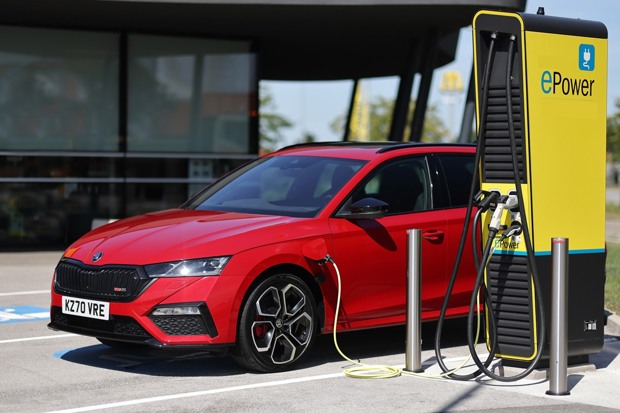
Date: 3 November 2021 | Current mileage: 3003 | Claimed economy: 40.3mpg | Actual economy: 32.2mpg
With 2030 looming large on the horizon, the switch to fully electric cars is well underway. Indeed Skoda has already introduced the Enyaq iV - one of the best electric cars around with a 260 mile range and a starting price of £32,000. Compare that to the likes of the Tesla range and it’s very affordable.
Whether cars like the Octavia vRS will continue beyond 2030 remains to be seen. Electric power can certainly give you the performance levels - but at a cost. However the biggest hurdle for many buyers will be the fun factor. Electric cars, while cheap to run and quiet, are rarely involving or engaging to drive. The Porsche Taycan shows it can be done, but that costs £85,000.
But the market is already changing as the car industry prepares car buyers for the switch to electric cars. So it’s perhaps no surprise to see the new Skoda Octavia vRS follow in the footsteps of the Skoda Superb and be available as a plug-in hybrid - badged TSI iV.
It combines a 1.4-litre petrol engine with a 10kWh battery to provide a total of 245PS - matching that of our 2.0 TSI. It’s not quite as quick, 0-62mph comes up in 7.3 seconds, but the big difference is economy. Thanks to the fact it can run on electric power for 44 miles, the WLTP figures come out as 224mpg.

Of course as we learnt from the Volvo V60 Polestar Engineered, you won’t actually get that, but with a 44 mile range, in theory you can cover plenty of school runs and trips to the shops without using the petrol engine.
I suppose the question is why are you buying a performance estate. For me about not only the performance but also the experience. The iV is smooth and economical but is it as enjoyable as the TSI? Plus there seems little point in buying a performance estate to then spend your time eeking out the best economy figures you can.
There’s also the question of price. I’ve already mentioned how much the Octavia vRS has gone up in price over the past six years but choosing the iV sees the list price top £38,500. I love a Skoda vRS don’t get me wrong, but even I think that’s a lot…
So while I did previously run a performance PHEV, this time around I’ve gone for a standard petrol engine. Something which in a few years won’t be an option. Time to make hay while the sun still shines…
The car that just loves to reset itself
Our Skoda Octavia is full of technology to make it safer and supposedly easier to live with, but it doesn't like to remember settings.
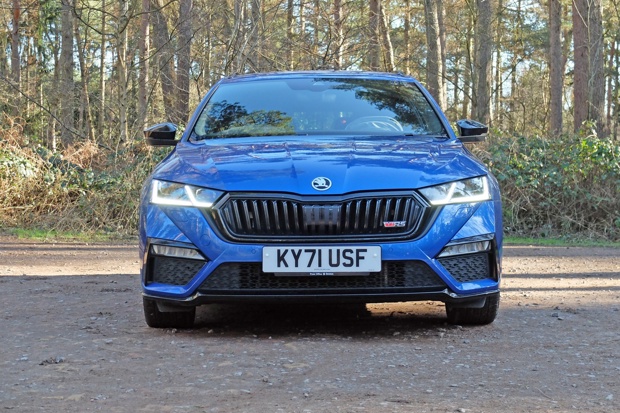
Date: 17 November 2021 | Current mileage: 3415 | Claimed economy: 40.3mpg | Actual economy: 31.9mpg
Like most people, I like my car a certain way. You know, the seat in a particular position, the mirror angled just so and the radio not left on anything weird. Like Fun Kids. And with the vast majority of modern cars having a growing list of functions with their own settings, this list has expanded.
As I’m a bit old school (or just old) whenever I get in a car I will turn off the auto stop start (fine in town but so frustrating on roundabouts) and make sure any lane assist system is deactivated. If there’s a drive mode setting, I also tend to set up my own custom one, usually with the steering in the sportiest setting but the suspension, engine and gearbox in standard.
I did the same when the Skoda first arrived, making a custom setting in the drive mode menu. The problem is, everytime you turn the Skoda off, it reverts back to the default settings. And it’s not just for the drive mode, it’s for everything. Even the air con.
So it’s now become a thing that every time I start the Octavia up I have to go through a routine of changing various settings before I’ve even gone anywhere. Something that’s not helped by the slow witted infotainment system (we’ll be covering that in a whole other update…)

So not only does this involve going into the car menu to change the drive mode, there’s then turning off the start stop (in another menu) then deactivating the lane assist, which fortunately is easy thanks to buttons on the steering wheel.
Phew done. You’d think. But hang on because the Skoda also resets the air con. Which I have set to sync so that both driver and passenger are on the same temperature. So this involves going into the climate menu and changing it to sync.
I realise now that this sounds like a proper moan about a few buttons, but it seems to make getting in the car and underway a real palaver (do people still use that word). Which it needn’t be. If only it would keep the settings in its memory.
Aside from that, the Octavia vRS is performing its role as family estate well. It’s even proving reasonably economical with us seeing around 32mpg despite most of our driving being around town and on between roundabouts on the bypass.
Skoda Octavia vRS - quiet on the outside, noisy on the inside
The Octavia vRS comes with a sound actuator which creates a fake sporty engine note in the cabin. Is it simply a gimmick?
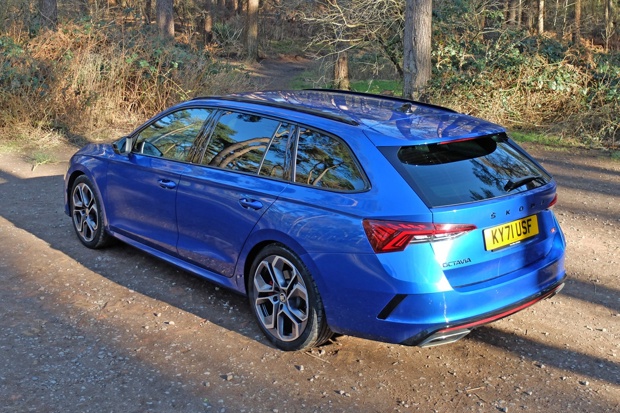
Date: 2 December 2021 | Current mileage: 3798 | Claimed economy: 40.3mpg | Actual economy: 32.0mpg
For me, the noise of a car is a crucial part of the enjoyment factor. When I passed my test all I ever wanted was some sort of ridiculous exhaust on my car to make it sound sporty. The fact my first car was a Mk1 Ford Fiesta with about 50bhp on a good day was neither here nor there.
When it comes to performance models and hot hatches, the noise is a key part. For many cars it’s become a trademark, like the distinctive sound a Porsche 911 makes from its flat six engines. On smaller cars, like hot hatches, the noise is mainly from the exhaust, after all who doesn’t love a burble and a pop as you come off the power.
While electric cars may be the future, for me there’s still nothing like the noise of an Audi RS3 accelerating with its 2.5-litre engine and huge exhausts. The Octavia vRS may not be quite in the same league as the RS3, but this is still a performance model.
So what may surprise you is the sound of the vRS from the outside. Because in terms of sportiness, it’s pretty non-existent. Stand next to the Octavia on start-up or when it’s running and you’d be hard pressed to tell it apart from a standard petrol Octavia. Those sporty looking exhausts don't actually create a sound.

But when you get inside, the Octavia vRS suddenly sounds the part. There’s a great low down engine note reminiscent of old Subaru models and burbles away as you accelerate. It’s lumpy, but in a good way.
What’s odd is that this sound is completely artificial. It’s actually a sound actuator which is designed to simulate engine noise in the interior. It works with a speaker fitted in the firewall between the engine and cabin, that pipes the noise to make it sound like the engine. It’s kind of like lip syncing, but for cars.
It’s something I first remember seeing on sporty Audi models and the Volkswagen Golf GTI several years ago. It has since made its way into lots of different models from the Porsche Panamera to the Ford Mustang.
It’s easy to dismiss these systems as being ‘fake’, but if they add to the enjoyment of driving does it matter? The other added bonus for us is that the sporty engine sound helps six month old Reuben go to sleep. Who needs white noise….
Where it all began for the Skoda Octavia vRS
The Octavia vRS is now 20 years old and has become a mainstay of the Skoda model range.
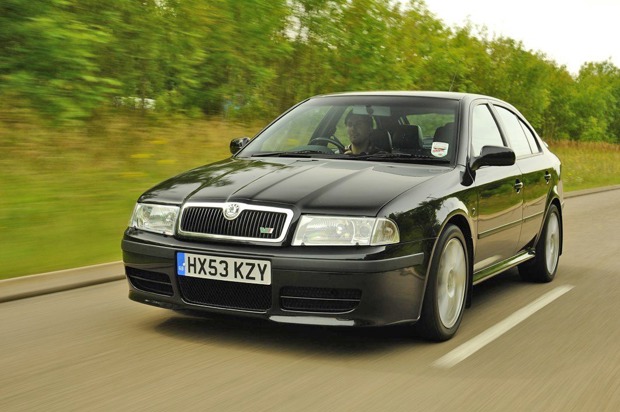
Date: 20 December 2021 | Current mileage: 4101 | Claimed economy: 40.3mpg | Actual economy: 31.9mpg
It has been 20 years since the vRS badge made its debut. Back then the idea of a sporty Skoda was seen as absurd by many people. At a time when the brand had just about shaken off its reputation for poor quality cars and Skoda jokes were still a thing, most people associated Skoda with practical and dull cars.
But 2001 saw the launch of the first Skoda Octavia vRS. The performance version of the Octavia has a turbocharged 1.8-litre engine borrowed from the Volkswagen Golf GTI. With 180PS it gave the vRS a 0-62mph time of less than 8.0 seconds and it looked the part too with chunkier bumpers, chrome exhausts, larger alloys and a rear spoiler. The price when new? £15,315.
Times have certainly changed. The latest Skoda Octavia vRS petrol has 245PS and the cheapest model is £32,365 - plus there are now diesel and plug-in hybrid versions. But some things remain - while it’s a hot hatch, it’s first and foremost a practical family car. Which is why the Octavia vRS is such a popular seller for Skoda in the UK.
So while Skoda no longer sells the Fabia vRS (like many we have fond memories of the original 1.9 TDI version) and has introduced a vRS version of the Kodiaq - the one vRS model that has remained consistent since 2001 is the Octavia vRS.

Going back to that original Skoda Octavia vRS shows you why it started such a successful lineage. It may be 20 years old but there’s still plenty to like. The one thing that stands out is how much fun it is to drive - something that was not a thing for Skoda’s at the time.
And it goes well too. While 180PS and a 0-62mph time of 8.0 seconds is what you get from a 2.0-litre diesel these days, the original Octavia vRS still feels eager with plenty of get up and go. True it’s quite soft in corners compared to our current one but the steering has that old school natural feel that’s missing in modern cars.
The original Octavia vRS has now moved into modern classic territory. But it’s still a bit of a bargain - you can pick one up for around £2000 but they are few and far between. We’ve only seen a handful on sale in the classifieds.
As for our Octavia vRS, it continues to perform faultlessly as our family car and we’re currently trying to improve the fuel economy which seems stuck around 33mpg at the moment.
The Skoda Octavia’s Simply Clever features
Skoda's 'Simply Clever' features have become a trademark of the brand and the new Octavia debuts several new innovations.
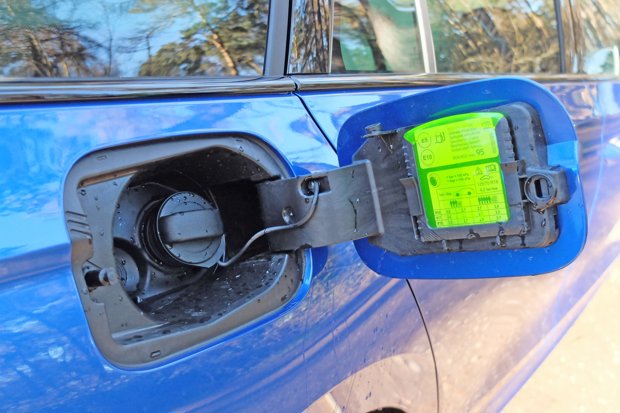
Date: 10 January 2022 | Current mileage: 4311 | Claimed economy: 40.3mpg | Actual economy: 32.7mpg
One thing I’ve always liked about Skoda models are their handy features. Dubbed Simply Clever by Skoda, these date back to 2001 and the original Skoda Superb which was available with umbrellas cleverly concealed in the doors - at the time the only other car that had this was a Rolls Royce Phantom.
Since then Skoda has introduced more than 60 of its Simply Clever features. And as is often the case - it’s these small but very useful extras that make life with a car much easier. The latest Skoda Octavia is no exception. Skoda’s philosophy is that every Simply Clever solution must be practical and easy to use. So that means a functional feature that makes life easier while being simple and affordable.
For me, the best of these new features are the umbrella in the front doors. Copying the larger Superb, these are incredibly handy if, like us, you find yourself out in the rain and have left your umbrella at home. We have found ourselves using them quite a few times already - although it tends to be the kids who want to use them whenever it rains.
Usefully, they come with an anti-bacterial coating to stop them going mouldy and the little storage slot is ventilated to help them dry more quickly. If you live somewhere decidedly more Scandinavian you can choose a snow brush instead of the umbrella.
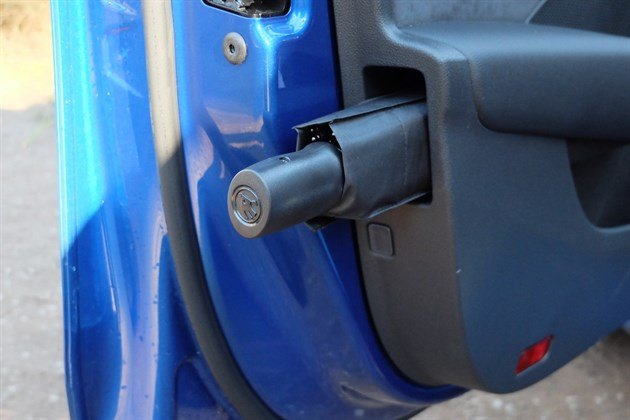
So what else do you get? Well there’s the usual car parking ticket holder on the front pillar - again so simple and cheap but very useful - plus the ice scraper in the fuel filler flap which now also includes a tyre tread depth gauge. In the recent cold weather I’ve found myself using this when I can’t find our big ice scraper (usually I’ve left it in the other car).
In the back there are two phone storage pockets on the front seatbacks - the kids aren’t quite old enough for phones yet but you’d be amazed how much Lego and how many Chewits you can fit in there…
I also find the button for the child safety locks really useful. It means I can turn the child locks on and off from the driver’s seat which is handy when you’re giving a grown up a lift as you don’t need to open the door for them like some sort of chauffeur. It’s also handy as we’re now teaching the kids to open the doors themselves when we get home.
What’s always amazed me is that other manufacturers haven’t followed Skoda’s lead. The Simply Clever ideas come from suggestions from Skoda customers and staff - none of them are expensive but they genuinely make life with the Octavia a bit easier. As a parent, that’s a real godsend.
What's fuel economy like in the Octavia vRS TSI?
While the Octavia TSI DSG has a claimed fuel economy of 40mpg, what exactly can you expect in every day driving?
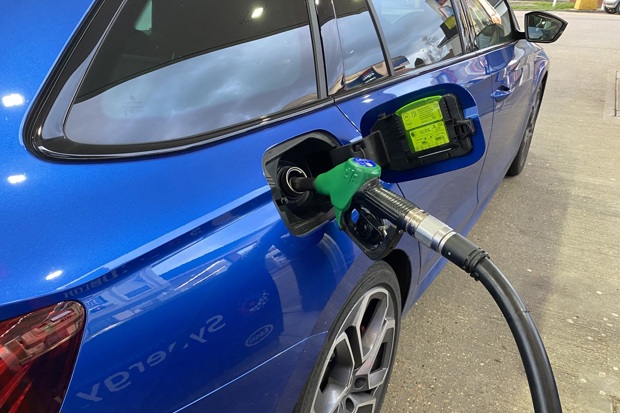
Date: 24 January 2022 | Current mileage: 4454 | Claimed economy: 40.3mpg | Actual economy: 33.0mpg
If it's fuel economy you want, a petrol Skoda Octavia vRS isn't the most obvious choice. The plug-in hybrid iV would be the better choice as I have previously mentioned. But as someone who is determined to enjoy internal combustion engined cars as much as possible before the ban in 2030, I was always going to choose the TSI.
If course common sense would say this isn't the wisest choice. The iV has a claimed economy of more than 220mpg thanks to the fact it can cover 40 miles on electric power alone. The 2.0 TSI on the other hand will only do 40.3mpg according to the official figures.
So what is fuel economy actually like? Well the good news is that you can actually achieve 40mpg in the Skoda Octavia vRS. And you don't have to drive like a funeral director to do it. On most motorway journeys, if you're cruising at 70mph, the Octavia vRS will average a respectable 40mpg, sometimes a bit more.
My journeys these days are less motorway however and more school run. That means lots of roundabouts and stop start traffic. The good news is that it's easy to keep an eye on your fuel economy in the Octavia. Not only does it have the usual instantaneous mpg readbout (which I always find distracting) it also gives you a long term average - and most usefully - an average since refuelling.

The Skoda resets this automatically every time you refuel and I've been finding it a very handy feature as I often forget to reset the average fuel economy display. I'm also a big fan of the Skoda digital cockpit which has various displays including the one above which I've settled on.
So in a sort of experiment I filled our Octavia vRS to the brim and used an entire tank, eeking it all the way down to a range of just 5 miles. For added excitement.
Over about two weeks I saw 33mpg which isn't too bad considering there was less motorway and more driving around MK as well as days out with the kids with a boot full of child related stuff. Like why are we taking scooters to the zoo?
I agree 33mpg is hardly what you call frugal but it's certainly better than the Audi RS4 Avant we ran that struggled to get to 25mpg. That 33mpg is also near identical to the fuel economy we saw in the previous generation Skoda Octavia vRS I ran in 2015.
A tale of two Skoda estates
While I'm running an Octavia Estate vRS for six months, our own family car is also a sporty(ish) Skoda estate...
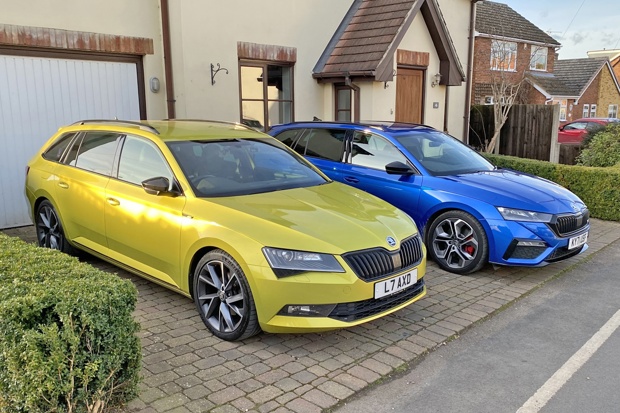
Date: 7 February 2022 | Current mileage: 4640 | Claimed economy: 40.3mpg | Actual economy: 33.2mpg
I've always loved an estate car. And I'm not really sure why. But there's something about a boxy back that just really appeals to me. I often think the estate versions of most cars are better looking and whenever a new model is launched, I'm always more excited to see the estate variant.
Which explains why I have run so many estate cars. From the Audi A6 Allroad to the Mercedes-AMG C43 Estate and now of course the Skoda Octavia vRS Estate. So what car do I have as our family car? Why an estate of course.
In fact it's another Skoda wagon - the Skoda Superb Estate. With three children we needed the biggest estate we could find and the Superb Estate fits the bill perfectly. It came down to a choice between that and a Volkswagen Passat Estate but the Skoda won the day. It replaced a BMW 320i Touring which itself followed a previous generation Skoda Octavia vRS Estate.
Sadly there's no vRS version of the Superb but ours is the next best thing, a Sportline. It's also finished in Dragon Green which is a colour I love and while the 2.0 TDI 150 isn't the quickest thing around, it's more than powerful enough for our family transport.
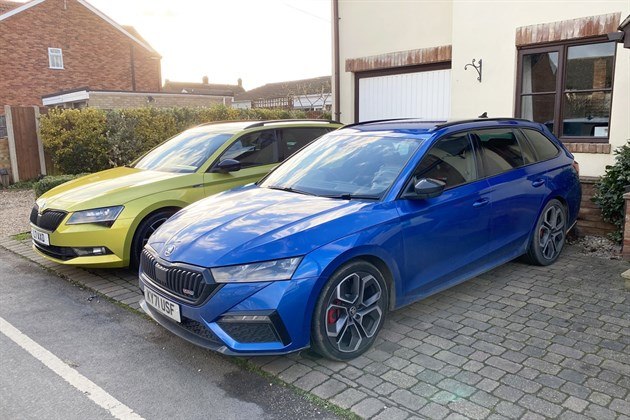
We looked at plenty of other estates like the BMW 5 Series Touring and Mercedes E-Class Estate but ultimately even those couldn't match the Skoda Superb Estate for rear passenger space. Plus we got a lot more Skoda for our money. Our pre-facelift 2018 Skoda Approved Used car was a bargain at just £15k. It really was a no brainer.
This was pre-Covid and with used car values rising at unprecedented rates, it's actually gone up in value in the 12 months we've owned it. If you want a similar age/mileage car now it's almost £2000 more expensive.
It's been very interesting comparing the two, especially the interior. The Octavia feels a bit more modern and advanced thanks to the digital cockpit, a larger touchscreen and a tiny gear selector rather than the now seemingly old fashioned gear lever in the Superb. But I still prefer the infotainment in the Superb which is quicker and less glitchy than the Octavia.
The sheer amount of space in the back of the Superb Estate is what truly sets it apart from the Octavia. With three children aged 8, 6 and six months, it's a squeeze in the Octavia but there are no such issues in the Superb. In fact I can have my seat all the way back and there's still acres of space for the kids and their car seats, even baby Reuben's rear facing Nuna.
How does the Octavia cope as a family car?
With three children and all their stuff, how does the Skoda Octavia Estate vRS cut it as a family car?

Date: 21 February 2022 | Current mileage: 4901 | Claimed economy: 40.3mpg | Actual economy: 33.4mpg
With three children and all their gear to carry about, it's no surprise our family car is a Skoda Superb Estate as I mentioned in my last update. So how does the new Skoda Octavia Estate perform when faced with the same task?
Both the Octavia and Superb are known for their space but when you have three children (with three car seats) in the back, most cars can be a squeeze. Up front there's very little difference in space between the two but in the back it's a different matter.
There's noticeably less legroom for our 8 and 6 year olds (the odd knee in the back of my seat lets me know) and with 10 month old Reuben in a rear facing seat, this means the front passenger seat has to sit quite forward.
It's all do-able but it feels much more of a squeeze than in our Superb Estate. Much of that is down to the narrower width too, it's a real struggle to get three car seats in the back and even more difficult for the children to put their seatbelts on. There's plenty of elbowing and grumping...

There are some plusses for the Octavia though. It has Isofix mounts in the front passenger seat which means I can have our youngest in the front when it's just him and me. Being able to keep an eye on him makes for far less stressful journeys as I can at least comfort him if he cries.
The boot is also usefully big as you'd expect. In fact with 640 litres of carrying space it's only 20 litres smaller than the Superb and feels just as big. However, it's not all perfect.
While I try and keep the Octavia vRS clean, the fact that half the Sahara desert seems to be making its way to us has meant a continual layer of dust sitting on the car. This has highlighted one of the design quirks with the Skoda Octavia Estate.
There's a dip in the rear bumper where it meets the bodywork and as a result water and dirt tend to collect there. So if you're not careful you end up either getting wet or dirty when trying to get things in or out of the boot. Not great when you're in your best outfit. It's not something we ever experienced with the old Octavia.
All good things must come to an end...
Our six months with the Skoda Octavia vRS Estate have come to an end. So how has it performed?
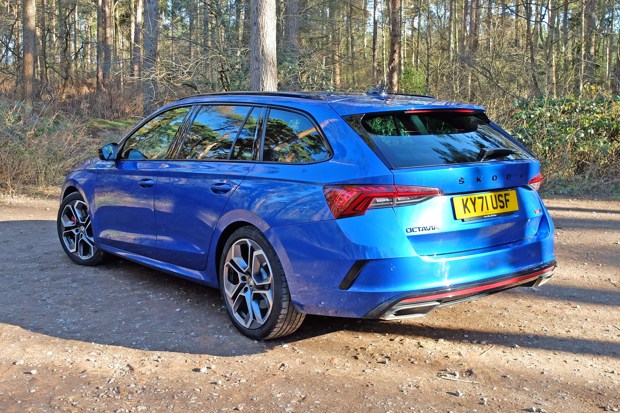
Date: 13 April 2022 | Current mileage: 6003 | Claimed economy: 40.3mpg | Actual economy: 33.6mpg
Well that six months flew by. It seems only a few weeks since our Skoda Octavia vRS arrived all shiny and new before it was subjected to life as our family car. And yet already it's making its merry way back to the good people at Skoda. After a thorough clean outside and most importantly, in.
So how has it performed over that time? Well for us, the obvious comparison has been with our own family car, a Skoda Superb Estate. The smaller Skoda Octavia obviously doesn't have quite as much room but it has proved very adept as our daily driver.
One big advantage of the Skoda Octavia over the Superb is the addition of Isofix for the front passenger seat, meaning we can carry our youngest up front. Very handy when it's just him and me. The big boot has been another plus and at 640 litres it's actually only 20 litres smaller than the Superb Estate, meaning plenty of room for our Nuna pushchair plus everything else that a one-year old needs to travel.
Of course the performance hasn't exactly been a hardship to endure. When I do occasionally end up in the car on my own, it's nice to be able to enjoy the strong turbocharged 2.0 TSI engine with its enjoyable, albeit artificially enhanced, engine noise.
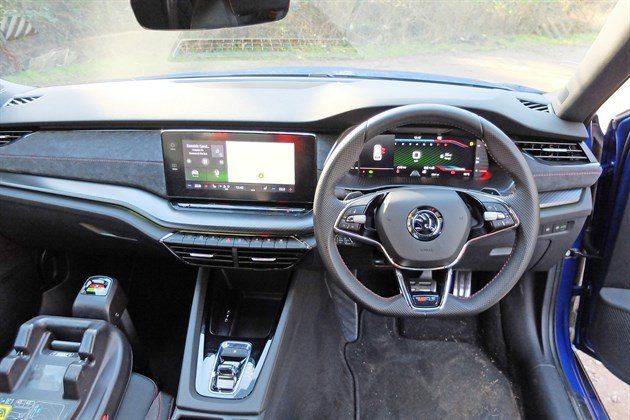
And this is what makes cars like the Skoda Octavia vRS so appealing to people who enjoy cars and aren't quite ready to throw in the towel just because they have children. It manages to combine family-friendly practicality with a bit of hot hatch performance. Yes there are compromises, but overall it's a great all-rounder in this respect.
The vRS model was in fact the best selling version of the previous generation Skoda Octavia, proving just how popular the formula is. The steering could be better and it's not the most involving of performance cars to drive but it's easy to forgive that of a car that also double as a comfortable family wagon.
Fuel economy in the Skoda Octavia vRS has been reasonable, with us seeing around 33 to 34mpg over the past six months. A few longer motorway runs saw that increase closer to the claimed 40.3mpg, which is not at all bad for a car with close to 250PS that is usually full to the brim with enough gear to rival a 1970s Genesis world tour.
As for its successor? Well I will be stepping away from an estate and switching to everyone's flavour of the month, a family SUV. Watch this space to find out what it is. One thing is for sure though, I will miss the Skoda Octavia vRS's all round capabilities.
A second opinion on the Skoda Octavia VRs: first impressions
David hands the Skoda Octavia VRs to Sarah Tooze for a few weeks for a second opinion.
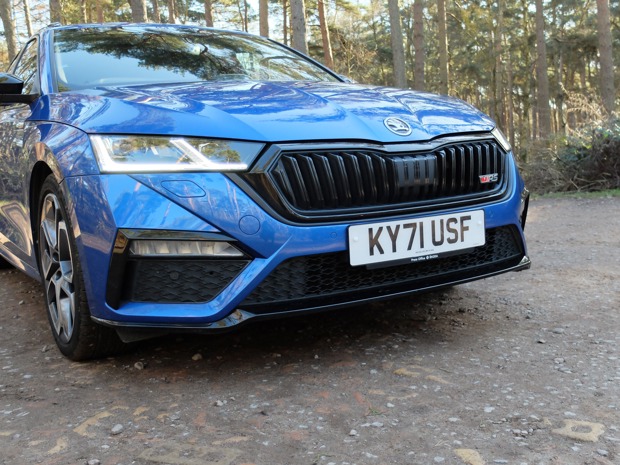
Date: 7 March 2022 | Current mileage: 5232 | Claimed economy: 40.3mpg | Actual economy: 33.6mpg
I’m no stranger to driving the Skoda Octavia as I tested both the estate and hatchback versions last year for industry title Fleet News. But there’s a big difference between the cars I tested and our current long-termer. They were the sensible plug-in hybrid (i.e. the most tax efficient version for company car drivers) versus our not-so-economical vRS.
But, as David explained in a previous update, there are good reasons why we didn’t choose the plug-in hybrid Octavia. Namely, that the vRS is much more fun. And having driven the Octavia vRS for a few weeks I can agree with that.
The first time I started up the Octavia vRS I was met with sound of a throaty engine, which took me back to the time I once tested a Volkswagen Golf GTD, which was fitted with a sound generator. Similarly, the Octavia enhances the existing engine noise with an artificial soundtrack, but it doesn’t cost extra.
The sporty feel continues with the interior styling. The standard seats are (no surprise) black sports seats with red stitching. The red stitching continues across the dash, which also features carbon-effect strips and there is 10.25-inch virtual cockpit, which can be set to a ‘sport’ layout. Pedals in an aluminium design and black roof lining complete the look.
All this can, at first, fool you into thinking the Octavia isn’t that spacious but that’s the beauty of this car - it is immensely practical as well as an enjoyable sporting estate.
The proof of that is seen by my daughter’s car seat. It’s a bulky item that spins 360 degrees, which is great for getting a wriggly toddler into the car without straining your back, but usually means the passenger in the front seat has little leg room. Not so in the Octavia.
I’m also a fan of the cavernous boot, which when I tested the Octavia estate before proved to be a godsend for family staycations when you have to cart a pushchair, travel cot, toys, books and all manner of other things to cater for a small person.
Added to that are Skoda’s Simply Clever features, which I agree with David are incredibly handy, particularly for parents.
